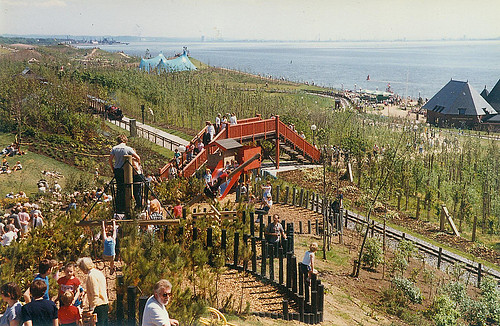sallybear
Well-known member
Apart from a short visit to a roller disco in the Pleasure Island complex, I haven’t been here since I was 8 when I visited the Festival Garden’s with my family, and remember it well.
My friend who is studying architecture has been using the site for her final thesis and we went to take some photos to accompany her work. Was amazed at the way this place has ended up. The way nature is completely retaking this place is amazing.
Bit of history:
In deepest south Liverpool, there is a garden where no one ever goes.(hmmm) Twenty years ago, it would have been full of people enjoying the views across the Mersey. In one summer alone more than 3.5m people flocked there to see its Japanese pagoda and wildlife gardens. But now it lies abandoned, with shopping trolleys half submerged in fishponds and piles of rubble in the main pavilion.
This isn’t a secret garden - when it opened in 1984 as Britain’s first garden festival, it was hailed as ‘a five month pageant of horticultural excellence and spectacular entertainment’. Even now it is passed every day by thousands of drivers travelling into Liverpool, who can still see many of the festival’s original sculptures and landscape features from the road. Yet few people have ventured inside the site for almost two decades, kept out by a rusting wire fence.
Of course, this is not how it was supposed to be. As one of five national garden festivals held during the 1980s and 1990s, the Liverpool event was supposed to act as a focus for regeneration and provide the setting for quality development in the future.
Based on the Bundesgartenschau, introduced in post-war Germany to bring war-damaged areas back into use, the concept was first mooted as a regeneration tool by former environment secretary Michael Heseltine in 1980. A programme of five festivals was devised, to be held biennially in Stoke-on-Trent, Glasgow, Gateshead, and Ebbw Vale, starting with the Liverpool international garden festival.
Each festival took a derelict piece of land, reclaimed it and turned it into green space for the event. While festivals only lived for one summer, it was hoped they would encourage investment and development long afterwards.
Some painted wood, not sure what it was from

Seating from the go-cart track, not sure if this was part of the later Pleasure Island

Tyre barriers from the carting circuit

One of the many wooden structures that linked parts of the site

Watch for the holes in the wood!

Found this inside large remains of building near the old carpark

Part of the Japanese Garden's

Massive doors near the remains of the festival hall

remains of the dragon slide, remember going down this as a child

Sculptures now hiding in the undergrowth

My friend who is studying architecture has been using the site for her final thesis and we went to take some photos to accompany her work. Was amazed at the way this place has ended up. The way nature is completely retaking this place is amazing.
Bit of history:
In deepest south Liverpool, there is a garden where no one ever goes.(hmmm) Twenty years ago, it would have been full of people enjoying the views across the Mersey. In one summer alone more than 3.5m people flocked there to see its Japanese pagoda and wildlife gardens. But now it lies abandoned, with shopping trolleys half submerged in fishponds and piles of rubble in the main pavilion.
This isn’t a secret garden - when it opened in 1984 as Britain’s first garden festival, it was hailed as ‘a five month pageant of horticultural excellence and spectacular entertainment’. Even now it is passed every day by thousands of drivers travelling into Liverpool, who can still see many of the festival’s original sculptures and landscape features from the road. Yet few people have ventured inside the site for almost two decades, kept out by a rusting wire fence.
Of course, this is not how it was supposed to be. As one of five national garden festivals held during the 1980s and 1990s, the Liverpool event was supposed to act as a focus for regeneration and provide the setting for quality development in the future.
Based on the Bundesgartenschau, introduced in post-war Germany to bring war-damaged areas back into use, the concept was first mooted as a regeneration tool by former environment secretary Michael Heseltine in 1980. A programme of five festivals was devised, to be held biennially in Stoke-on-Trent, Glasgow, Gateshead, and Ebbw Vale, starting with the Liverpool international garden festival.
Each festival took a derelict piece of land, reclaimed it and turned it into green space for the event. While festivals only lived for one summer, it was hoped they would encourage investment and development long afterwards.
Some painted wood, not sure what it was from

Seating from the go-cart track, not sure if this was part of the later Pleasure Island

Tyre barriers from the carting circuit

One of the many wooden structures that linked parts of the site

Watch for the holes in the wood!

Found this inside large remains of building near the old carpark

Part of the Japanese Garden's

Massive doors near the remains of the festival hall

remains of the dragon slide, remember going down this as a child

Sculptures now hiding in the undergrowth






































